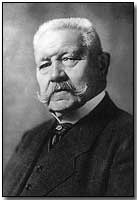Who's Who - Paul von Hindenburg
 Paul von Beneckendorff und von Hindenburg
(1847-1934) was born in Poznan on 2 October 1847, the eldest of three sons, and was educated at cadet schools in Wahlstatt and Berlin.
Paul von Beneckendorff und von Hindenburg
(1847-1934) was born in Poznan on 2 October 1847, the eldest of three sons, and was educated at cadet schools in Wahlstatt and Berlin.
He first saw military action at the Battle of Koniggratz in 1866 and in the Franco-Prussian War of 1870-71. He was subsequently appointed to the General Staff in 1878, reaching General rank in 1905. He married Gertrud von Sperling in 1879 while stationed at Strettin; they had three children, a boy and two girls.
Hindenburg retired from the army 1911. The outbreak of the First World War led to his inevitable recall on 22 August 1914, being sent to the Eastern Front as Commander of East Prussia. The Germans scored a notable victory at Tannenberg in August 1914, where Hindenburg overcame a much larger army, leading to his appointment as Commander-in-Chief of the German armies in the East in September 1914.
Further victory at the Masurian Lakes in 1915 resulted in his being hailed as the saviour of East Prussia, although his Chief of Staff Erich Ludendorff - who held this position with Hindenburg throughout the war, remaining a close ally - is generally credited for achieving these victories.
Hindenburg was consequently promoted to Field Marshal, finally becoming Army Chief of Staff on 29 August 1916, succeeding the man with whom he'd violently disagreed with concerning Eastern policy, Erich Falkenhayn, and whose downfall he had helped to engineer. He immediately appointed Ludendorff his Quartermaster General.
Now in a position of power, Hindenburg, in conjunction with Erich Ludendorff, and with the support of senior officers and prominent industrialists, formed what was known as the 'Third Supreme Council', a military-industrial dictatorship that held virtually total power until 29 September 1918 when, with defeat inevitable, power was returned to the Reichstag.
Whilst Chief of Staff Hindenburg, again largely acting under Ludendorff's direction, managed to stem the Allied advance on the Western Front, and consolidated the formidable Hindenburg Line, which ran from Lens through Saint-Quentin to Reims. Romania was quickly defeated after discarding its neutrality and entering the war on the side of the Allies; and Russia was forced out of the war in 1917.
Hindenburg oversaw the final great German push of spring 1918 in France, which ran from March to July. A costly offensive, it almost succeeded. However an Allied counter-offensive, bolstered by the arrival of U.S. troops, broke through, forcing German surrender in November 1918.
A popular hero, Hindenburg retired once again from the German army in June 1919, but remained in office (click here to read Hindenburg's account of Kaiser Wilhelm II's abdication). Under the terms of the Treaty of Versailles Hindenburg was due to be tried as a war criminal; however his popularity ensured that he was not even indicted.
Hindenburg became President of the Weimar Republic in 1925, replacing Friedrich Ebert upon the latter's death, achieving re-election in 1932. Hindenburg, by then virtually senile, was responsible for appointing Adolf Hitler Chancellor in 1933, fearing civil war otherwise.
Such was Hindenburg's popularity that Hitler chose not to remove Hindenburg from office, preferring instead to wait for his death, on 2 August 1934, at which point constitutional government was disbanded.
Click here to read Hindenburg's summary of the 1914 Warsaw campaign; click here to read his Warsaw Army Order; click here to read his report following German victory at Tannenberg; click here to read his summary of the decision to abandon fighting at Verdun; click here to read his account of the German defence at Cambrai in 1917. Click here to read Hindenburg's account of the opening of Spring Offensive of 1918. Click here to read a summary of the Lys offensive. Click here to read Hindenburg's official address dated 6 September 1918 in which he warned German soldiers to beware of Allied propaganda. Click here to read Hindenburg's post-war reflections upon the opening of the Battle of Amiens on 8 August 1918. Click here to read Hindenburg's call for the opening of peace negotiations in October 1918. Click here to read a series of telegrams exchanged between Hindenburg and Ferdinand Foch regarding an armistice.
To view film footage of Hindenburg click here and here.
A "blimp" was a word applied to an observation balloon.
- Did you know?
